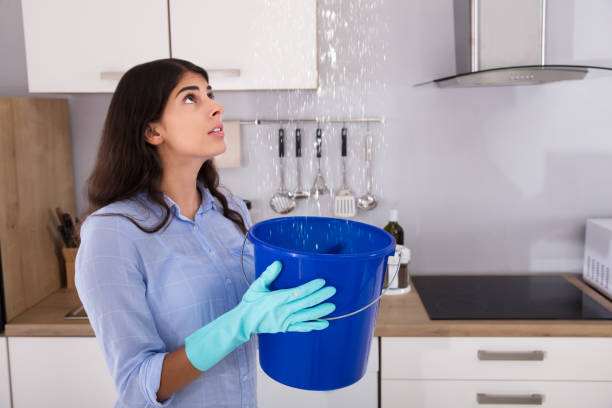
Understanding the Causes of Roof Leaks
Poor Installation
Roof leaks often arise from poor installation practices. These issues can stem from various factors, including:
- Improper Flashing Installation: Flashing is the material used to direct water away from roof joints and seams. If not installed correctly, it can lead to leaks around chimneys, vents, and skylights.
- Faulty Shingle Placement: Shingles must be aligned and secured properly to form a watertight seal. Misaligned or improperly nailed shingles can create gaps for water to seep through.
- Inadequate Underlayment: The underlayment acts as a secondary barrier against water intrusion. An insufficient or improperly installed underlayment can compromise the roof’s integrity.
Wear and Tear
As roofs age, they naturally experience wear and tear. Common issues include:
- Cracked or Missing Shingles: Exposure to harsh weather conditions can cause shingles to crack, curl, or become dislodged.
- Worn-Out Sealant: The sealant around roof penetrations, such as vents and pipes, can deteriorate over time, leading to leaks.
- Clogged Gutters: Debris accumulation in gutters can cause water to back up and overflow, leading to leaks and potential damage to the roof.
Identifying Roof Leaks
Before embarking on repairs, it’s crucial to identify the source of the leak accurately. Here are steps to help you pinpoint the problem:
Inspect the Roof Exterior
- Check for Visible Damage: Look for missing, cracked, or curled shingles. Examine the flashing around roof penetrations and the seams for any signs of damage or poor installation.
- Examine Roof Valleys: Roof valleys are areas where two roof planes meet. These areas are prone to leaks if not properly flashed or if debris accumulates.
Inspect the Roof Interior
- Look for Water Stains: Check your attic or ceiling for water stains or discoloration. These stains often indicate the location of the leak.
- Inspect for Mold or Mildew: Mold and mildew growth can be a sign of persistent moisture issues and may point to the leak’s source.
Conduct a Water Test
- Simulate Rainfall: Using a garden hose, simulate rainfall on different sections of the roof. Have a helper inside the attic or home to observe where the water appears. This can help you pinpoint the exact location of the leak.
Repairing Roof Leaks
Once you’ve identified the source of the leak, follow these steps to repair it:
Safety First
- Wear Proper Gear: Safety is paramount when working on a roof. Wear a harness, and non-slip footwear, and use ladders safely.
- Work in Good Weather: Choose a dry, calm day for repairs to ensure your safety and the effectiveness of the repair.
Repairing Poor Installation Issues
- Reinstall Flashing: If flashing was poorly installed, remove the damaged flashing and replace it with new, properly installed flashing. Ensure it is correctly sealed and secured.
- Realign Shingles: For misaligned or damaged shingles, lift the affected shingles and realign or replace them as necessary. Secure them with roofing nails and seal any gaps with roofing cement.
- Replace Underlayment: If the underlayment is damaged, remove the affected area and install a new underlayment. Ensure it overlaps with existing sections to maintain a watertight barrier.
Repairing Wear and Tear Issues
- Replace Missing or Damaged Shingles: Remove the damaged shingles and replace them with new ones. Ensure they are properly aligned and nailed down. Seal the edges with roofing cement if needed.
- Reseal Penetrations: For worn-out sealant around vents or pipes, remove the old sealant and apply a new layer of roofing sealant or flashing tape. Ensure it is applied evenly and covers all gaps.
- Clean and Repair Gutters: Remove debris from gutters and ensure they are properly attached and sloped. Repair any leaks or damage to the gutters or downspouts.
Preventing Future Roof Leaks
Once repairs are completed, taking steps to prevent future leaks is essential:
Regular Roof Inspections
- Schedule Professional Inspections: Have your roof inspected by a professional at least once a year. They can identify and address potential issues before they become major problems.
Maintain Gutters and Downspouts
- Clean Gutters Regularly: Keep gutters clean and free of debris to ensure proper water flow and prevent overflow.
- Check Downspouts: Ensure downspouts are directed away from the foundation to prevent water damage.
Address Roof Vulnerabilities
- Install Roof Barriers: Consider installing roof barriers or membranes in vulnerable areas, such as roof valleys or around roof penetrations, to provide extra protection against leaks.
- Upgrade Roofing Materials: If your roof is old or frequently experiencing issues, consider upgrading to more durable roofing materials that offer better resistance to wear and tear.
Conclusion
Repairing roof leaks caused by poor installation or wear and tear is a crucial task to ensure the longevity and effectiveness of your roofing system. By understanding the common causes, identifying the leak accurately, and performing the necessary repairs, you can safeguard your home from further damage. Regular maintenance and inspections will help prevent future issues and extend the life of your roof. Remember, when in doubt, consult a roofing company Michigan to ensure repairs are done correctly and safely.